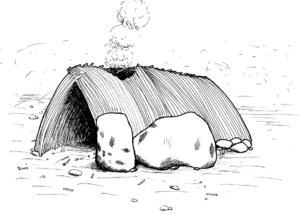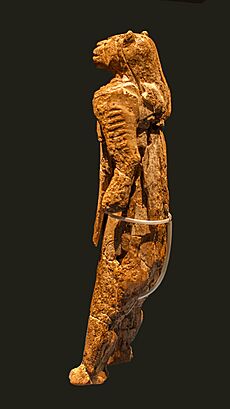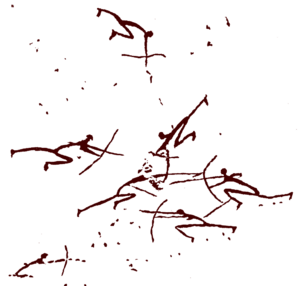Timeline of prehistory facts for kids
This article is a timeline of prehistory. It covers the amazing journey of Homo sapiens (that's us!) from when we first appeared about 315,000 years ago in Africa. It goes all the way up to the invention of writing over 5,000 years ago, around 3,200 BC. Prehistory is the time before written records. It stretches from the Paleolithic (Old Stone Age) to the start of ancient history.
All the dates you see here are estimates. They can change as scientists make new discoveries or learn more from old ones!
Contents
The Middle Stone Age: Early Humans and New Skills
The Middle Stone Age, also known as the Middle Paleolithic period, was a time of big changes. Early humans, including our ancestors and Neanderthals, started developing new tools and ways of life.
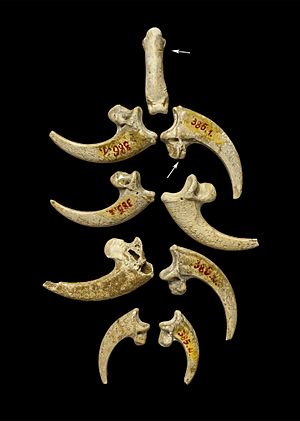
- Around 320,000 to 305,000 years ago: People in Olorgesailie, Kenya, made better tools. They also started trading things over long distances.
- Around 315,000 years ago: Our species, Homo sapiens, first appeared. This was in Jebel Irhoud, Morocco.
- Around 250,000 years ago: Homo neanderthalensis (Neanderthals) first appeared.
- Around 230,000 years ago: The Terra Amata site shows the first known purpose-built structure. It was likely made by Homo heidelbergensis.
- Around 210,000 years ago: Modern humans were present in southeast Europe.
- Around 200,000 years ago: The oldest known grass bedding was used. It included plants to keep insects away!
- Around 195,000 years ago: The Omo remains of early humans were found in Ethiopia.
- Around 170,000 years ago: Humans started wearing clothing.
- Around 164,000 years ago: Humans began eating seafood, expanding their diet.
- Around 130,000 years ago: Evidence of ancient seafaring was found in Crete. This island was cut off from land for millions of years.
- Around 120,000 years ago: Early humans used symbols etched onto bone. They also used marine shells for decoration.
- Around 120,000 to 90,000 years ago: The Sahara desert region was wet and fertile.
- Around 100,000 years ago: The earliest known structures were built in Egypt. They were made of sandstone blocks.
- Around 75,000 years ago: The Toba supervolcano erupted. Scientists once thought it caused a big drop in human numbers. Now, they are not so sure.
- Around 70,000 years ago: The earliest example of abstract art was found. It was a stone with patterns from Blombos Cave, South Africa.
The Late Stone Age: Art, Tools, and Spreading Out
The Late Stone Age, or Upper Paleolithic, saw humans become even more creative and spread across the world. They developed amazing art and new technologies.
- Around 80,000 to 40,000 years ago: Evidence of Australian Aboriginal Culture appeared.
- Around 50,000 years ago: The earliest evidence of a sewing needle was found. It was made and used by Denisovans.
- Around 45,000 years ago: The earliest known painting of animals was found. It showed three pigs in a cave in Sulawesi.
- Around 45,000 to 43,000 years ago: The first groups of Homo sapiens arrived in Europe.
- Around 42,000 years ago: Paleolithic flutes were made in Germany.
- Around 42,000 years ago: Early humans in East Timor had advanced deep-sea fishing skills. This shows they could travel across oceans.
- Around 40,000 years ago: Neanderthals became extinct.
- Around 40,000 years ago: The Aurignacian culture began in Europe.
- Around 40,000 years ago: The oldest known animal sculpture, the Löwenmensch figurine (Lion-man), was created.
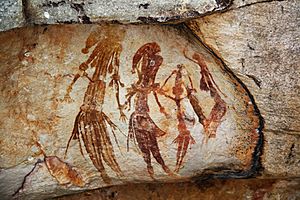
- Around 40,000 to 30,000 years ago: The first human settlements were formed by Aboriginal Australians. These were in areas that are now cities like Sydney and Melbourne.
- Around 35,000 years ago: The oldest known human figure sculpture, the Venus of Hohle Fels, was made.
- Around 33,000 years ago: The earliest evidence of humanoids in Ireland was found.
- Around 31,000 years ago: Earth ovens were used in Central Europe.
- Around 31,000 to 16,000 years ago: The Last Glacial Maximum occurred. This was the coldest part of the last Ice Age.
- Around 30,000 years ago: Rock painting began in Bhimbetka rock shelters in India. This area has hundreds of rock shelters with paintings.
- Around 28,500 years ago: New Guinea was settled by people from Asia or Australia.
- Around 28,000 years ago: The oldest known twisted rope was found.
- Around 28,000 to 24,000 years ago: The oldest known pottery was used. It was for making figurines, not for cooking.
- Around 25,000 years ago: A village of huts made from rocks and mammoth bones was founded. This was in Dolní Věstonice in the Czech Republic. It is the oldest known permanent human settlement.
- Around 23,000 years ago: It is thought that wolves started living with humans. This led to the domestication of the dog.
- Around 23,000 to 21,000 years ago: The earliest known human footprints in North America were left. These are now at White Sands National Park, New Mexico.
- Around 20,000 to 19,000 years ago: The earliest pottery for cooking was used in Xianren Cave, China.
- Around 18,000 years ago: The Magdalenian culture appeared in Europe. They created famous cave paintings like those in Lascaux and Altamira.
- Around 17,000 years ago: The earliest gene for blond hair was found in Siberia.
- Around 14,200 years ago: The oldest agreed domestic dog remains were found. This was the Bonn-Oberkassel dog, buried with two humans.
- Around 14,000 to 12,000 years ago: The oldest evidence for prehistoric warfare was found.
- Around 13,000 to 10,000 years ago: The last Ice Age ended. The climate warmed, and glaciers melted.
- Around 13,000 to 11,000 years ago: The earliest dates for the domestication of the sheep were in Mesopotamia.
- Around 12,900 to 11,700 years ago: The Younger Dryas occurred. This was a sudden period of cooling.
The Holocene: New Ways of Life and the Rise of Civilizations
The Holocene is our current geological epoch. It began with a rapid warming trend. This period saw huge changes in how humans lived, leading to farming, settled villages, and eventually, the first civilizations.
- Around 9600 BC: A sudden period of global warming began. This marks the start of the Holocene epoch.
- Around 9600 BC: Jericho shows evidence of settlement. It was a popular camping spot for hunter-gatherers.
- Around 9400 BC: The earliest date for the domestication of the pig is suggested.
- Around 9000 BC: The earliest ceremonial structures were built at Göbekli Tepe in Turkey. This might be the oldest religious site on Earth.
- Around 8900 to 8300 BC: People in the Amazon basin started growing cassava. This was the first domestic crop in the Americas.
- Around 8500 BC: The earliest date for the domestication of cattle is suggested.
- Around 8000 BC: The earliest dates for the domestication of the goat are suggested.
- Around 8000 BC: Many large ice age animals, like the mammoth and sabre-toothed cats, became extinct.
- Around 8000 to 7000 BC: In northern Mesopotamia (modern Iraq), people began growing barley and wheat. They used them for beer, soup, and later, bread.
- Around 7500 to 3500 BC: The Sahara desert region was a fertile savanna. Lake Chad was much larger than the current Caspian Sea.
- Around 7500 BC: The urban settlement of Çatalhöyük was founded in Turkey.
- Around 7500 BC: The earliest date for the domestication of the cat is suggested.
- Around 7200 BC: The first human settlement in Amman, Jordan, was built.
- Around 7000 to 6000 BC: Early European farmers arrived in Europe. They brought agriculture with them.
- Around 7000 BC: Maize (corn) was domesticated in southern Mexico. It quickly became a main food source.
- Around 7000 BC: The Kuk Swamp in Papua New Guinea became a center for farming. People grew bananas, sugarcane, and other crops.
- Around 7000 BC: The Jiahu culture began in China.
- Around 7000 BC: Human settlement began at Mehrgarh in South Asia. This is one of the earliest sites with evidence of farming.
- Around 6200 to 6000 BC: A sudden drop in global temperatures occurred. This led to drier conditions in East Africa and Mesopotamia.
- Around 6000 to 3000 BC: Early forms of writing, called proto-writing, developed. This happened in China, Southeast Europe, and West Asia.
- Around 6000 BC: Evidence of people living in Aleppo, Syria, dates back to this time.
- Around 5500 BC: Copper smelting (melting copper to make tools) was happening.
- Around 4500 BC: The oldest known gold treasure was found in Bulgaria.
- Around 4000 BC: Civilizations began to develop in the Mesopotamia region. This area is often called the Fertile Crescent.
- Around 4000 BC: The earliest dates are suggested for the domestication of the horse, the domestication of the chicken, and the invention of the potter's wheel.
The 4th Millennium BC: The Dawn of Recorded History
The 4th millennium BC was a time of incredible progress. Large settlements grew into cities, and the invention of writing changed everything.
- Around 3800 BC: The Trypillian people built huge settlements in Ukraine. Some had 15,600 to 21,000 people!
- Around 3600 BC: The first monumental buildings were constructed in Sechin Bajo, Peru. This was possibly the oldest civilization in the Americas.
- Around 3500 BC: The Uruk period began in Sumer.
- Around 3500 BC: The first evidence of mummification was found in Egypt.
- Around 3500 BC: The African humid period ended. This made the Sahara desert dry and led to more people moving to the Nile Valley.
- Around 3400 BC: The oldest known picture of a wheeled vehicle was found on a pot.
- Around 3300 BC: The Bronze Age began in the Near East. People started using bronze tools.
- Around 3300 BC: Newgrange was built in Ireland.
- Around 3200 to 2500 BC: The Norte Chico or Caral–Supe civilization began in Peru. They built the first cities in the Americas.
- Around 3200 BC: The Yamnaya culture appeared. They likely spoke the Proto-Indo-European language.
- Around 3200 BC: The Sumerian cuneiform writing system was first used. This marks the beginning of recorded history!
|
See also
- Human timeline
- List of languages by first written accounts
- Timeline of ancient history
- Timeline of human evolution
- List of periods and events in climate history
- Prehistory by world region
- Near East
- Prehistoric China
- Prehistoric Europe
- Pre-Columbian Americas
- Prehistory of Australia


